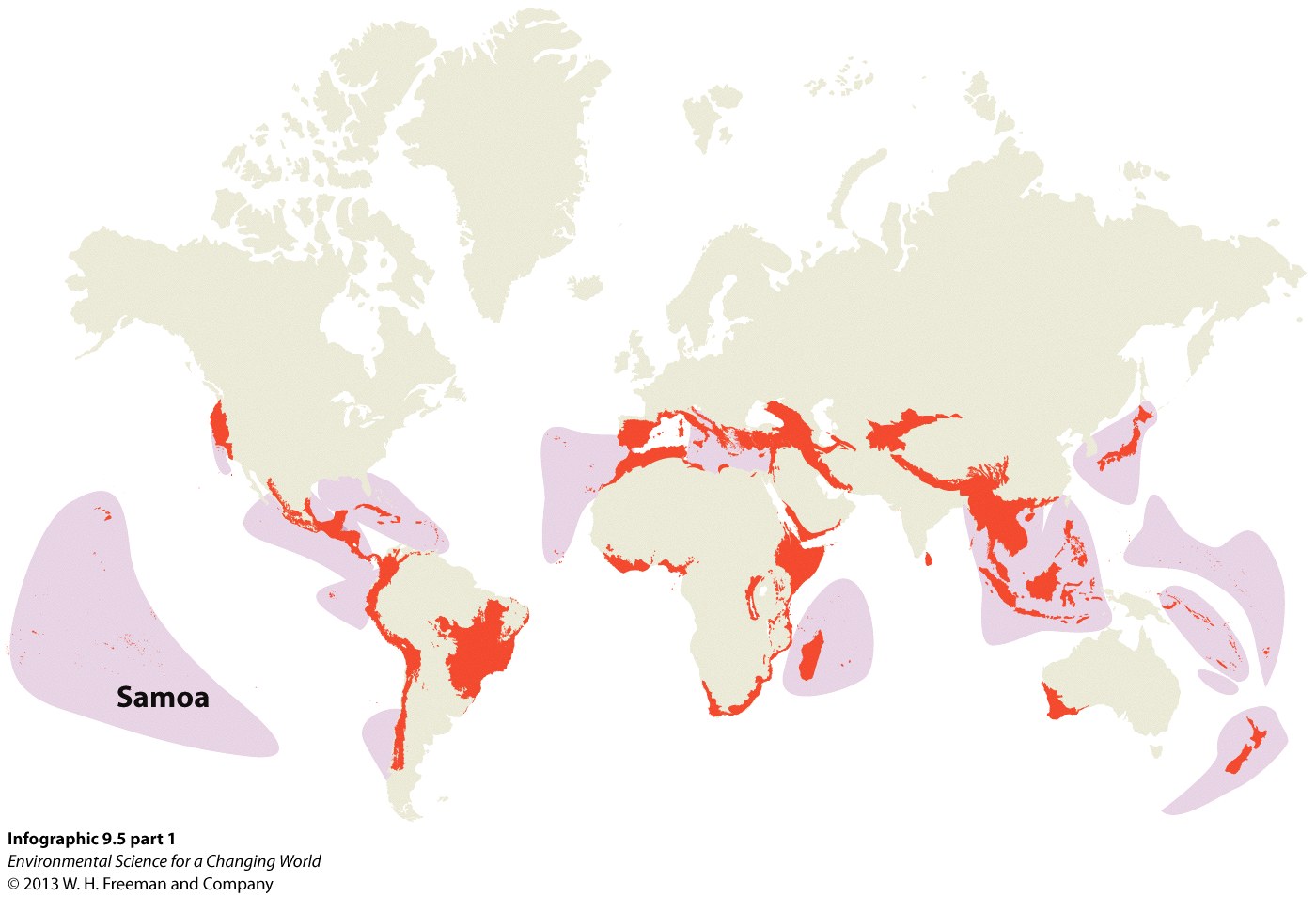Chapter 9. Chapter 9: Biodiversity
What are biodiversity hotspots and why are they important?

Guiding Question 9.4
What are biodiversity hotspots, and why are they important?
Why You Should Care
Biodiversity hotspots are parts of the world that have a particularly high level of biodiversity and endemism (having species that only occur in one area or a particular habitat that is itself rare). These areas are of high concern for all the reasons that you have already learned make biodiversity important, and because many of them are in areas with high human population density. Probably the most famous and emblematic example of an extinction from a biodiversity hotspot is the dodo. The dodo was a flightless bird related to the pigeon, the size of a medium-sized dog and that lived only on the island of Mauritius in the Indian Ocean far off the coast of Madagascar. Within 80 years of Mauritius’s discovery by Europeans in the early 1600s, every last dodo had been eaten by sailors and the animals they brought with them. This was probably the first time that the possibility that a species could go extinct was contemplated by the Western world, and the dodo has entered our language in set phrases like "dead as a dodo" or "gone the way of the dodo," meaning dead, gone, and never to return.
Question Test Your Vocabulary
Choose the correct term for each of the following definitions:
| Term | Definition |
|---|---|
| yFYZ98IwCmwUrecfdQyNG6K0kMEoPcIvfC3E+E7RQkHEoEoLs1rl3Xvf2YX17y+g | Describes a species that is locally extinct in one or more areas but still has some individual members in other areas. |
| 6uncIrzbmkmNZZXriPOt10cRTdNdgHSahlogiruPISRQn7o3b565yYX+6FWPpvMW | Describes a species that is native to a particular area and is not naturally found elsewhere. |
| GOb2iRYYJnqgHKiuKRxHgb7EY8fFVuCqPsa7sFztEscwSc30+5lhVlt36xKNlwky | An area that contains a large number of endemic but threatened species. |
Question 9.1
ZpMcx1yW+MgOmx+6m8k0R8fKlABi99hLjpW3TrU+eGhzQnBtNgqzU6DDgBAURJxCkjOuw5Z1/oaFxFtIdYgBm2vvedK84qAAVY33+nW9hEvz6bfuCWAZiTI/H0/IT9JA/NEHk40DPauIAOtvmh57dm0MaVhBvCSSyMCFJUc5zeO4A3GnfeuMWnbvKmlLHpKvraph04lYudx3AYxZQuestion 9.2
IRJ//HRQuOk5QoqmYsoMcp8r4z19QgWrSjQ4qEHXYF5OW75b7ai1QHozphCrTfuJ9f7XXECJvPEaXFZ36iqkGL1RwpdCmHPWMYqC9yv+uDUsCbaOcJ7jTb30kuvq/2+k0231rfN+zxsX0INoL/sWRshvP5zjzriawzHSWaqqsIM69xfF+8YlRrdp4mFjhbJQnJX1b0HLZdImbMar/rroFQ==
Question 9.3
yOnQtjkK7LqzmnUVaQEaGKGFVEmDXt4ow5lrbn0tZZT6G0Q2fPN4pgV9FOsrhOSVHXzzD/dQkY7CLtqBHyyuci6wKssMSh+xHeBAG61AVc2/lKw54zACqJAMHXPTR1nmv1iHJFha9fdt+dEaNmGE3/lt+A0v872uN1EzwujvrAEPOGGRMm9ZocYLbJTtokun5MDGAh6LYmoBKg89I6xzPM5BzoO570Nbyok4gMG2/Raz2NN6S6mjd4YxLQGUiPm2BCvK9yTpiePp5AFIqJUc7HBmE+idPI7NsJ5sFTBGde0jht3bgIRqhCT+rIhz8XnmUTA+V42jcEZF2DIcUXZJJLc4mTasz/iNFzj2s6i8EbbsnWyuVsuAY1ZaJSlBR/pCj/jnxjq3F89JslNPiWWYCEZ4IvXmezy+JwP9xM71ITVMt3yr0XXj82dm6PU2oJE7TItU9A==Question 9.4
JPKbT3527+bwiT8e2+Tg35hLoi7+bF2rJ1Ke21aPRTpQtBEWwt6VWvTs13CzPpnTkEyfkJjReQqdhFSvQeHKruTUtvIwW7tGIWQLEwb7Li8qdNBBdA/n4G5rnqdgc8BZXNFQzXypfKdSAes7/tNDvbKAwia35L/hddzIRNmE7KnZbRYDSj35a/ME7CPIvXe+01zH8tLcWSAAPzSkdPyoeOavgy6sO/0v21F7IA==Question 9.5
21B4kBjOq2KZtLlGk8WHVIfTF70hFm3W8m9kZd7roL+3BdRmbg4g6ExA/7eQ+1uprKemOwGIh5BGW1ffvsywozPzVgMDKP7hWA2qVSqv9zC200irKCNGcF+P3mqL0rDeZDJdPmrKdLzR9KTeVdlNSKXRvIfSQjXcQuestion 9.6
TmUve4nra/47HWGhtQt7Zzc9+3pKroej3Bc5yWHRvzQ8/gTIBa+fzPLTQSep6Lwyf+5vplR+z81Lw5gvsMlYPuFlLkX8z6TTsUOJCMYGaDDmYG/VV4zYBn6lVP6+MB5ndgyTUJFlZcdZmNRQFPAO/vo+5rL1OgpJkoeK6LaSEv0TagqLI6XC1UkhwwMPGgcFR/NduJoG1nHWX4e1H8ktKQ==Question 9.7
IOrbn6MaYarhqiyJjlG+nMxOvq5tJ+OuL8ZOk2xEOwm0BRbthhQMFSrrzJqJ/D8KehXozy1Eq1dADrCyVpO836SO5voFKKEFzSNF9x/8j5E=Question 9.8
BM9qwb0vEfJMHQypuQUnHixtR0ifKsA6kQ40FI4YIBJzOs89zQhFDjLdvbzn5le3oLC7uKgawYGxxIMNXwiSaFfigNNBBPewnZODVDaSj62YpONm/dF6PXkbriByrltGOciptS8RxB/HuAnuqJgWP5ngysXa7FmAPi7G9SnrnAW3p2NIRJatjiD5Ioyj1xIxcdTr8ku5PlC43NP2M2RwdFkWR8B6hdOLFRCBmQX0LhzdO8H4XypXrJy9rpAB+aFYjL8YPMQVn4+qNQ1ZEct2YzNFGh488UXgFhxg864H6W04QqVUCrpkmvYM877ZRnjqfJ6dpQ==Question 9.9
eGTv52z2rHH59d9hWj2G6kHp+8nE1yw+bMcNudXLZCF8f+HksDcJyJXSPJTp/b2nzUWLiXORk06dy1BZWroU6QzamJ3NbRTvnpP/3uwUpgjOPRkxcovDQmLv3H9XPgITNoiWXOxwN8E6ANG7mpVftkeXjOwnmDLmElwQYB18CC4fqaLUQK6cst2toXecFyxhoRzYam5qcOb4+UPIv1lq4AG3eULi9dXW3xMjH5W+3xvcUTl/Jb6fP8SytTkiDeDe4OeJfpnulsgqvAhrfOjfe2FB6xh6+rWzV02l7A==Question 9.10
OQtNGoVUZ4MT7iWKVWKJ7KZD2rLn9C0ZvlwAhss1F/Kbi0RJMQtSKWMHbpb/gub8uQNhvZMIqUo29x+pY+Y2a7lMLRpABLUSwPV64FZMzmWCrHlZYbTAlcQKWcTzijM4GQ5eRKl8Kz6XUPgNE2nNYudUs4Jsds21EjEt5r0ZAs9OQPXlxF1zpoSRbBP7O7mygnfjQ16s3xfNRFXBGft24Ad81wDvmQFgz0PkM+X25z2TV/WTYu18SScee+ZZjV7gpfvUH893K7ag2fFhci4axSaUYlUHlSxGmxlHIf6hbbokDeSN2PL/Gg==Question 9.11
Internet Exercise: Use this biodiversity hotspot website maintained by the organization Conservation International to search for threatened and endangered species in other hotspots. Make sure to compare threatened and endangered species on islands and continents. Then answer the following questions:
g+T6RjtHFmvx3e/BTxg81aTv800Qw/Pm5CNw/h29XvjIb/YrJ9+jatUEejc9u0CJetxbd4qXoKCsaCEAW9nJWnKMFKahsvxHl6CdCA== WZ/PCtnjAUdbQzQx4bgdY6h/hBWAfZtDFsjbVN6eyN0VCcFExuJiyPExJY2vaJcWVIQUJA80SvIBkIHy1dsww+8XtY2wnTeU1c9HKFqCU0+K03mhLFZbCA53DeRiswLdw+0s2obwYEnOJwXYL05d/HXuQJDa6fnBVyRTs52j22vYc2MKWT8G9g==Flightless birds
Birds in general
Butterflies
Certain kinds of plants, such as orchids
B) There are typically more threatened species on islands. Often, this is because species evolving in isolation lose defenses crucial to survival against the larger variety of predators on mainland continents.